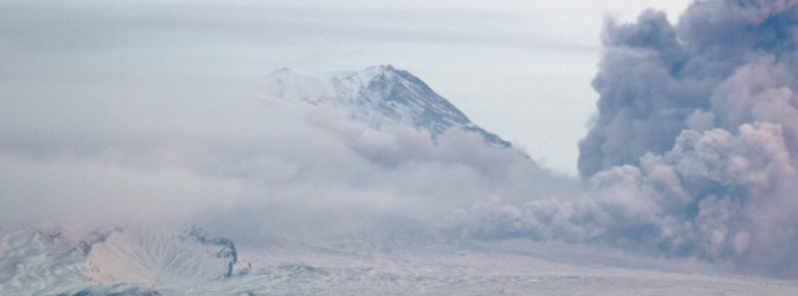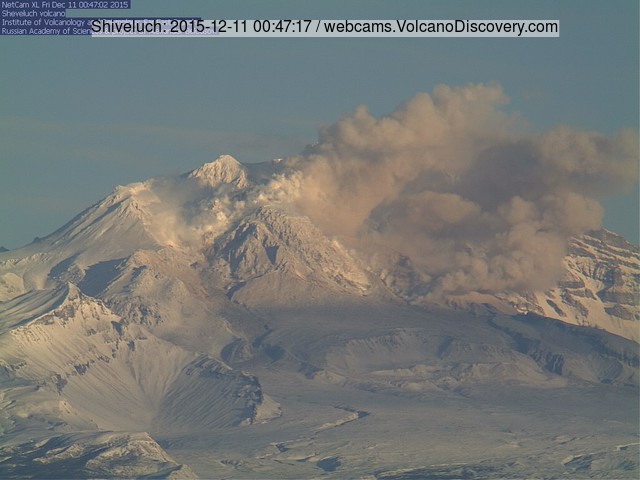Shiveluch erupts sending ash up to 5 km into the air, Russia

Shiveluch volcano in the east of Russia erupted on December 21, 2015, raising ash columns up to 5 km (16 404 feet) above the sea level, the Kamchatka Volcanic Eruption Response Team (KVERT) reported. Orange alert level remained in effect.
Hot avalanches from the volcano collapsed from the southwestern flank of the lava dome at 02:31 UTC and rising ash plumes drifted about 15 km (9 miles) to the east-southeast of the volcano. The explosive-extrusive eruption continued and ash explosions rising up to 10 km (32 800 feet) are expected to occur at any time. KVERT warns the volcano activity could affect international and low-flying aircraft.

Small avalanche at Shiveluch volcano generating a small ash plume, December 11, 2015.
According to Global Volcanism Program (GVP), in the period between December 4 and 11, lava-dome extrusion onto Shiveluch's north flank was accompanied by fumarolic activity, dome incandescence, ash explosions and hot avalanches. A daily and intense thermal anomaly over the dome was detected on satellite images. Ash plumes rose between 4 and 4.5 km (13 100 to 14 800 feet) and drifted 130 km (80.8 miles) on December 4, 6 and 11 while the Aviation Color Code remained orange.
Geological summary
The high, isolated massif of Sheveluch volcano (also spelled Shiveluch) rises above the lowlands NNE of the Kliuchevskaya volcano group. The 1300 cu km (312 cu miles) volcano is one of Kamchatka's largest and most active volcanic structures. The summit of roughly 65 000-year-old Stary Shiveluch is truncated by a broad 9 km (5.6 miles) wide late-Pleistocene caldera breached to the south. Many lava domes dot its outer flanks. The Molodoy Shiveluch lava dome complex was constructed during the Holocene within the large horseshoe-shaped caldera; Holocene lava dome extrusion also took place on the flanks of Stary Shiveluch.
At least 60 large eruptions have occurred during the Holocene, making it the most vigorous andesitic volcano of the Kuril-Kamchatka arc. Widespread tephra layers from these eruptions have provided valuable time markers for dating volcanic events in Kamchatka. Frequent collapses of dome complexes, most recently in 1964, have produced debris avalanches whose deposits cover much of the floor of the breached caldera.
Featured image: Ash cloud over hot avalanches fronts which collapsed from the lava dome of Molodoy Sheveluch volcano on November 30, 2015. Image credit: Yu. Demyanchuk/IVS FEB RAS, KVERT

This may come as a shock to you, but there are multiple forces at work in the climate and it’s dynamics. Burning fossil fuels produces CO2 which slowly drives up the surface temperature and the temp. of the sea and lakes.
Burning those fuels also produces particulates and sulfur dioxide, which reflect some of the heat which would otherwise be adsorbed. They attenuate the heating, but don’t prevent it. The sad irony is that if we were to stop burning fossil fuel, we would see 1.1 to 1.4 degrees C. of heating, global average, since the beginning of the industrial age. More than double what we are already experiencing. It would kick in within a couple of years. The CO2 we have already emitted takes about 40 years to fully express itself in the temps. So we would get a quick blast of heating and then we would continue heating from the current CO2. If we keep burning them, then we keep the parasol open and have a bit of relief, but we drive the heating on for much longer, making it eventually too hot to survive. It doesn’t really matter any more, as the methane is free-releasing from the arctic. It’s 150 times more effective a greenhouse gas than CO2 upon emission. Now that it is out of our control, we are just along for the ride. It will be a rough ride.
Complete turn around – Now NASA says burning fossil fuels ‘COOLS planet’ If there is global warming is not happening, change the agenda to cooling! It’s mans fault!
Solar activity, solar cycles, low solar output has nothing to do with it. OK!